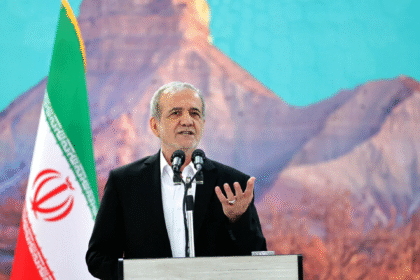Israel Launches 12-Hour Bombardment on Tehran as Iran Plots Retaliation for U.S. Strikes
Israel launches a 12-hour air assault on Tehran, targeting key military sites as Iran prepares a powerful response to recent U.S. strikes. Tensions in the Middle East escalate rapidly
Israel launched wide-ranging strikes on Tehran on Monday that it said targeted a paramilitary headquarters and a notorious prison, pressing on with its bombing campaign a day after the United States entered the conflict with strikes on a trio of Iranian nuclear sites.
The new Israeli barrage, which a military spokesman said was focused on “command centers” of the powerful Revolutionary Guards, came as Iran fired salvos of missiles that sent Israelis to huddle in shelters.
As the damage from the latest strikes was still becoming clear, world leaders called on both sides to ease their attacks, even as President Trump’s decision to join Israel’s campaign against Iranian nuclear sites raised fears that the war would escalate. American military and intelligence officials detected potential signs that Iran-backed militias were preparing to attack American bases in Iraq, and possibly Syria.
Iranian officials appeared to be weighing their options for retaliation against the United States. Iran’s foreign minister, Abbas Araghchi, met with President Vladimir V. Putin of Russia on Monday as the Kremlin seemingly sought to push back against the suggestion that it was offering little support to Iran. Even though Russia is a longtime ally of Iran, there has been little sign so far that Moscow is prepared to provide military assistance to Tehran in this war.
More than 24 hours after U.S. bombers hit three uranium-enrichment sites in Iran, prompting Mr. Trump to declare that Iran’s nuclear program had been “totally obliterated,” the actual state of the program seemed far more murky, with senior officials conceding they did not know the fate of Iran’s stockpile of near-bomb-grade uranium. On Monday, the Israeli military also said it had struck access routes to the Fordo site in order to obstruct them.

Trump administration officials emphasized on Sunday that the United States did not want an all-out war with Tehran, but Mr. Trump’s position was less clear — particularly when he raised the prospect of regime change in Iran in a social media post on Sunday. He was set to meet with his National Security Council on Monday.
Here’s what else to know:
- Calls for peace: After European foreign ministers met to discuss Iran, the European Union’s chief diplomat, Kaja Kallas, said that “the concerns of retaliation and this war escalating are huge.” The International Atomic Energy Agency was holding an emergency meeting in Vienna, where the head of the agency, Rafael Grossi, warned that “violence and destruction could reach unimaginable levels” if Iran, Israel and the United States do not find a path to diplomacy.
- Possible response: Mr. Trump’s decision to attack Iran seemed likely to dim hopes for a negotiated solution to end the fighting, only days after the president had indicated he would wait for as long as two weeks to give diplomacy a chance. While U.S. officials say that Iran has depleted its stockpile of medium-range missiles, the country still has an ample supply of other weapons, including rockets and drones.
- The strikes: Pentagon officials described a tightly choreographed operation that included B-2 bombers carrying 30,000-pound bunker-buster bombs and submarine-fired Tomahawk cruise missiles hitting a trio of sites in less than a half-hour. A senior U.S. official acknowledged that the attack on Fordo had not destroyed the heavily fortified site, but it had been severely damaged.
- Economic impact: Asian markets dipped on Monday, reflecting investor concern over possible economic fallout from the U.S. strikes and any potential moves by Iran to disrupt shipping through the Strait of Hormuz, a critical transit point for global oil supplies.
On June 23, 2025, the Israel Defense Forces (IDF) initiated a 12-hour intensive air campaign targeting multiple strategic and symbolic sites across Tehran—including Revolutionary Guard command centers and Evin Prison—directly responding to U.S. airstrikes on Iran’s nuclear infrastructure
Reports indicate over 400 deaths, primarily civilians, according to Iranian officials
This operation was part of a larger campaign codenamed Operation Rising Lion, which began mid-June and has already struck over 100 key military and nuclear targets across Iran since June 13
Earlier, the U.S. carried out precise strikes on Iran’s Fordow, Natanz, and Isfahan nuclear facilities using B-2 bombers and bunker-buster munitions—termed Operation Hammer by the Pentagon . President Trump, while endorsing strong military action, hinted at regime change in Iran .
Despite President Trump asserting “spectacular military success,” international responses included calls for de-escalation from the UN, France, Germany, and China, as they warned against escalation threatening global security
In response to Israel’s attacks, Iran has launched missile and drone strikes into Israel, causing significant casualties—over 24 civilian deaths and hundreds injured. Tehran has also announced deep consultations with Russia to coordinate a broader response, while publicly maintaining diplomacy is untenable until vengeance is exacted .
The Iranian parliament has approved a motion to close the Strait of Hormuz, a critical chokepoint for global oil shipments—though such a move carries severe economic and logistical risks
As Israel intensified its strikes, a mass exodus from Tehran ensued. Thousands fled, seeking refuge in northern provinces as air raid alerts and supply shortages prompted mass evacuations .
Meanwhile, Iran’s currency—the rial—tumbled to record lows (≈705,000 IRR/USD) as civilians rushed to secure hard currencies in fear of broader conflict.
Dissident voices within Iran expressed concern not just about war, but growing domestic instability and civil disillusionment
Israel’s offensive was strategically preceded by covert Mossad-led drone sabotage operations, which neutralized air-defense systems and missile launchers before the aerial assault even began. Estimates suggest upwards of 200 Israeli aircraft hit over 100 targets, integrating intelligence and airpower in a highly synchronized operation.
This marks a paradigm shift in modern warfare—covert drones paving the way for overt bombings, amplifying tactical impact while limiting initial resistance
Saudi Arabia, Qatar, and the UAE condemned the strikes as sovereign violations, urging restraint.
European leaders, including the UK’s Keir Starmer, voiced support for Israel’s self-defense while cautioning against escalation .
Energy markets reacted sharply: oil prices spiked, global traders spooked by threats to the Strait of Hormuz
Observers noted that Israel’s initial raids were precisely measured, avoiding nuclear and civilian infrastructure to minimize escalation risk and preserve international support. As Richard Haass noted, the strikes were “more about signaling than punishing”.
Analysts caution, however, that Iran may now be compelled to respond to maintain deterrence. Tehran faces the twin dilemmas of escalating too far—or appearing weak—each with significant consequences
- Further missile and drone attacks on Israel or U.S. regional forces.
- Strategic harassment of merchant shipping in the Strait of Hormuz.
- A diplomatic push with Russia or China to present a united front.
But Iran’s capabilities have been weakened following setbacks in Syria and Lebanon, reducing effectiveness of its proxy forces.
Meanwhile, the U.S. appears to be offering a two-week diplomatic window, signaling restraint and hoping to avoid wider war
Energy disruption: Even rumors of Hormuz closure led to market instability.
Humanitarian crisis: Evacuations and displacement challenge Iran’s regional stability.
Credibility of deterrence: How Iran and Israel respond next will reshape regional security outlooks.
War Powers scrutiny: U.S. domestic debate intensifies over Congress’s role in approving military interventions
Read Also : White House Releases 7 Dramatic Situation Room Photos from U.S. Airstrikes on Iranian Sites








